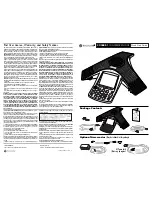
1
GS2060/GS2065: Are General Packet Radio Service/Global System for Mobile (GPRS/GSM) wireless alarm
Communicators that send alarm communication to Sur-Gard System I, II, and III (SG-DRL3IP) central station
receivers via a GPRS/GSM digital cellular network.
TL260GS/TL265GS: Are Dual-path GSM/Ethernet alarm Communicators that send alarm communication to
Sur-Gard System I, II, and III central station receivers through Ethernet/Internet or a GPRS/GSM digital cellular
network.
The Communicator can be used as either a backup or primary Communicator. The Communicator supports
Internet Protocol (IP) transmission of panel and internal events over Ethernet/Internet and/or GPRS/GSM.
The GPRS/GSM performance of the GS2060/GS2065/TL260GS/TL265GS Communicators depends greatly
on GSM network coverage. The unit should not be mounted in the final location without first performing the
Communicator Placement Test on page 8 to determine the best location for radio reception (minimum of one
green LED ON). Optional antenna kits are available from DSC at: http://www.DSC.com.
NOTE: Prior to installation of the Communicator, confirm with your carrier that the GPRS/GSM network
is available and active in the area where the Communicator will be installed and that radio signal
strength is adequate.
Panel Mounting
The following Communicators are compatible with PC1616/PC1832/PC1864:
•
GS2060
(GPRS/GSM only)
•
TL260GS
(Ethernet/In GPRS/GSM dual-path)
The following Communicator models are compatible with ALEXOR PC9155;
•
GS2065
(GPRS/GSM only)
•
TL265GS
(Ethernet/In GPRS/GSM dual-path.
NOTE: When GS2065 is installed in ALEXOR, panel model is 9155G. When TL265GS is installed, panel
model is 9155D.
Features
Technical Specifications
The input voltage to the Communicator can be drawn from the Underwriters Laboratories/Underwriters Labora-
tories Canada (UL/ULC) Listed Control Panel or provided by an external UL/ULC Listed power supply rated for
the application (external power-limited source).
NOTE: The power supply must be Class II, Power Limited.
UL/ULC Installation Requirements
NOTE: For equipment used at the protected premises and intended to facilitate IP communications
(hubs, routers, Network Interface Device(NID)s, Digital Subscriber Line (DSL)/Cable modems) 24 hour
back-up power is required. Where such cannot be facilitated, a secondary (back-up) communication
channel is required. Programming for Domain Name Service (DNS) is not permitted in UL/ULC Listed
systems.
Notes for using Private, Corporate, and High Speed Data Networks:
Network access and domain access policies shall be set to restrict unauthorized network access, and spoofing
or Denial of Service (DoS) attacks. Select an Internet Service Provider (ISP) that has redundant servers/sys-
tems, back-up power, routers with firewalls enabled, and methods to identify and protect against DoS attacks
(e.g., via spoofing).
Notes for using Public Switched and Wireless Data Networks:
Communication channels shall be facilitated such that the Communicator will restrict unauthorized access,
which could otherwise compromise security. Communicators shall be located in secured areas.
•
For ULC Residential fire and burglary applications the GS2060/GS2065/TL260GS/TL265GS can be used as pri-
mary communication channel via either GSM or Ethernet or as a back-up in conjunction with the Digital Alarm
Communicator Transmitter (DACT). Test transmission every 24hours shall be enabled on each channel.
•
For ULC Commercial Fire and Burglary applications the GS2060/TL260GS can be used as a passive com-
munication module with the following Security Levels:
• P1 (each channel GSM or Ethernet is independent),
• P2 (GSM and Ethernet in back-up configuration, panel Section [851][005] Toggle Option [5] OFF),
• P3 (GSM and Ethernet in redundant configuration, panel Section [851][005] Toggle Option [5] ON).
•
The module can be also used as an Active communication system with the Security Levels A1-A4 (each
channel GSM or Ethernet independent or together in a back-up/redundant configuration). For Active Line
Security systems AES128 bit encryption shall be enabled at the monitoring station receiver and the supervi-
INTRODUCTION
• 128-bit AES encryption via GPRS/GSM and Ethernet/Internet (NIST Validation Certificate No. 995).
• Activating, initializing and remote programming through Connect 24.
• Back up or primary GPRS/GSM alarm communication.
• Ethernet LAN/WAN 10/100 BaseT (TL260GS/TL265GS only).
• Full event reporting.
• Fully redundant Ethernet/Internet and GPRS/GSM Dual-path Alarm Communication (TL260GS/TL265GS only).
• Individual Ethernet and/or GPRS Periodic test transmission.
• Integrated call routing.
• Panel remote uploading/downloading support via GPRS/GSM and Ethernet/Internet.
• PC-Link connection.
• Programmable Labels (Zone and Partition Labels autosync with the ALEXOR 9155 v1.1+ panels only)
• Quad-Band Operation: 850 MHz, 900 MHz, 1800 MHz, and 1900 MHz.
• SIA format (Contact ID GS2065/TL265GS V1.1 only).
• Signal strength and Trouble display LEDs.
• Subscriber Identity Module (SIM) card included with Communicator.
• Supervision heartbeats via GPRS/GSM and Ethernet/Internet.






































